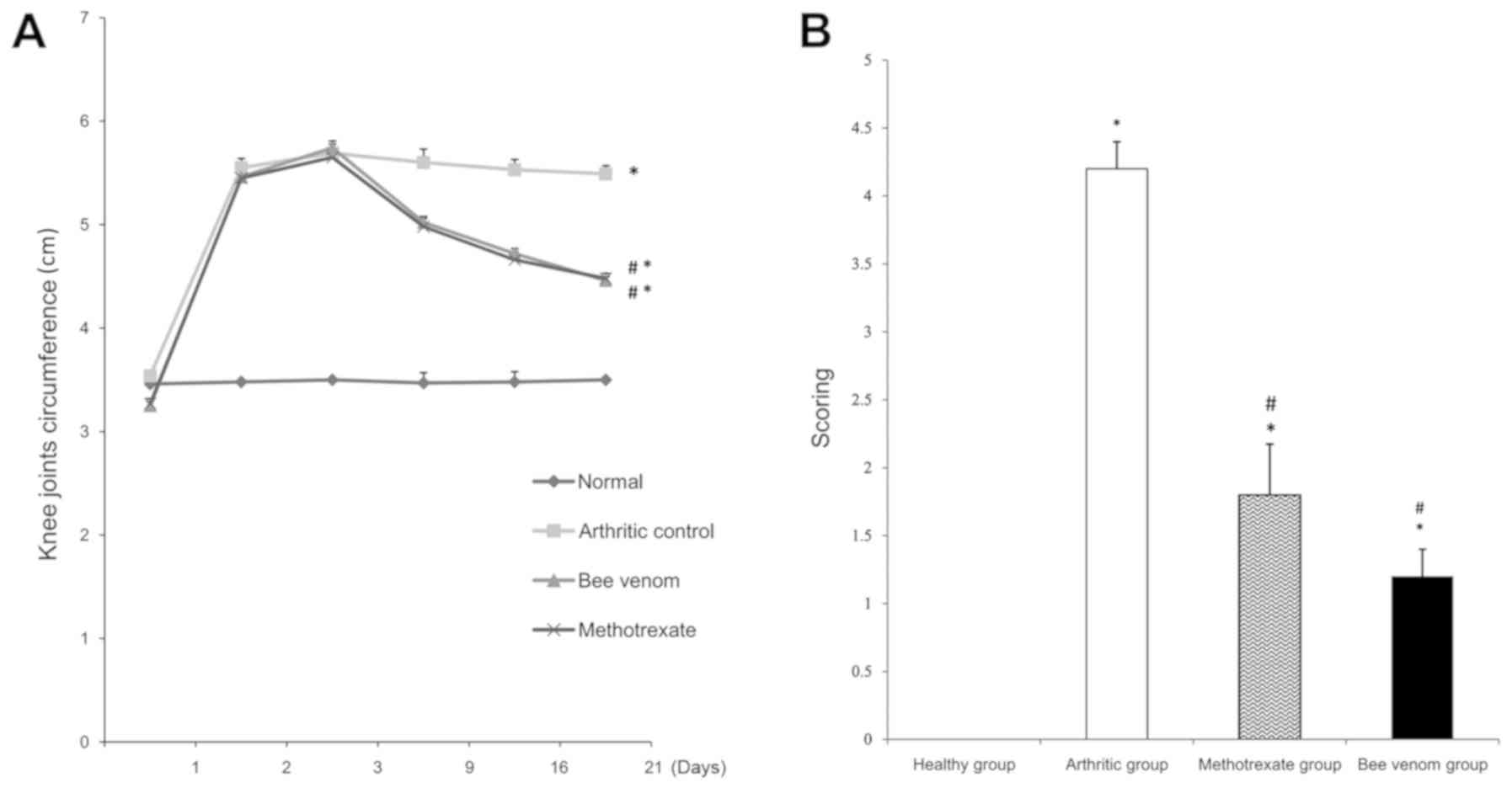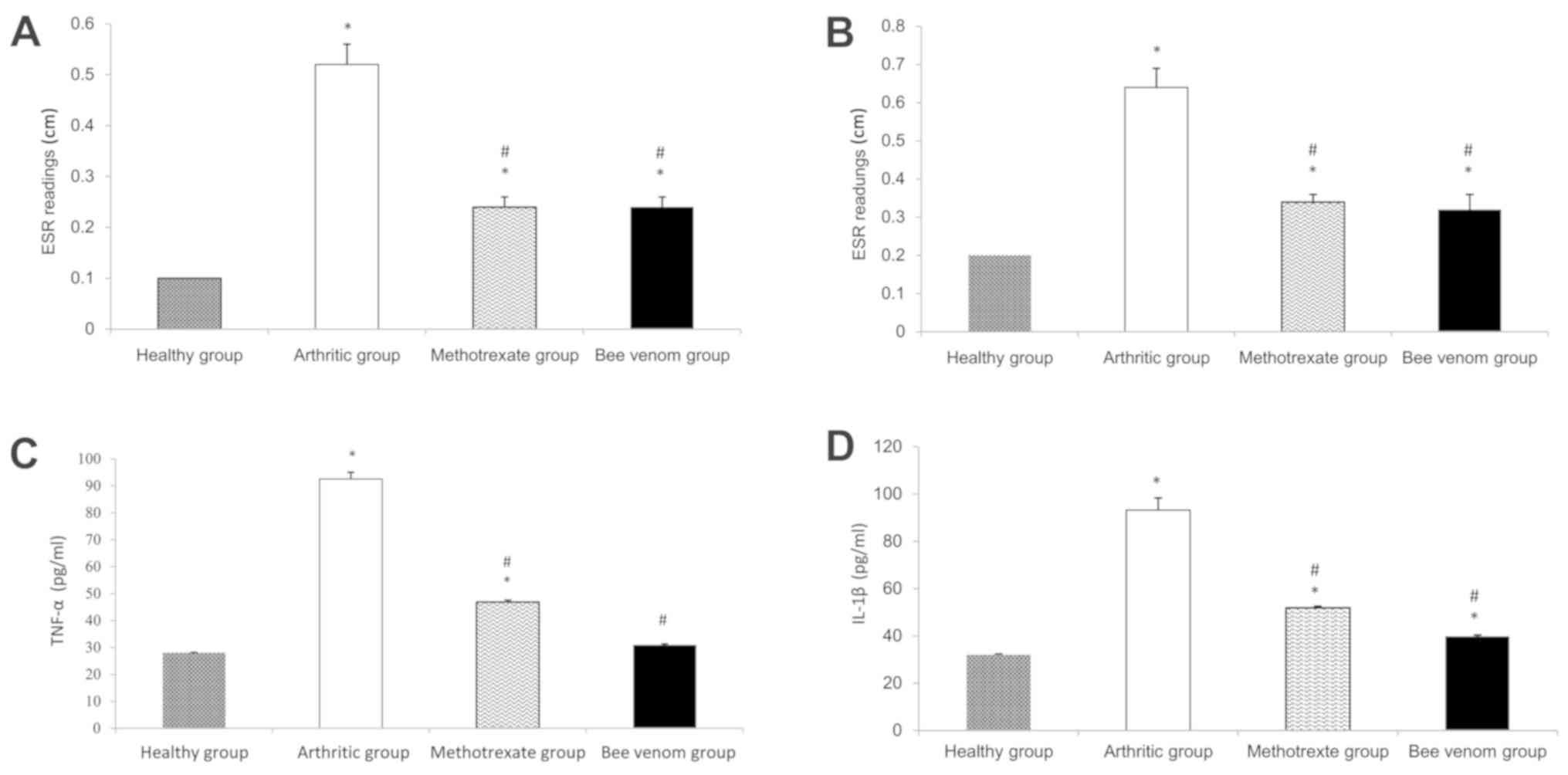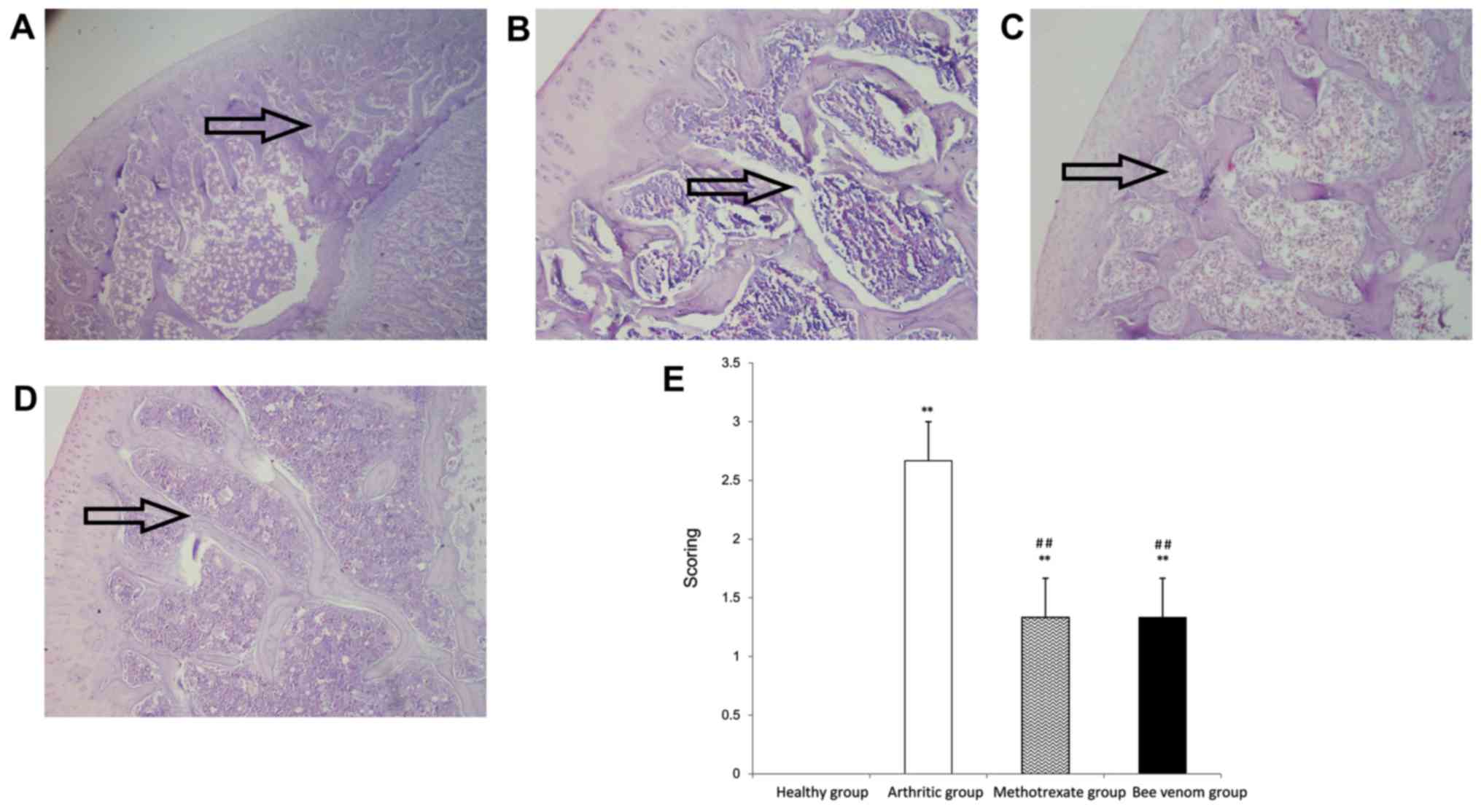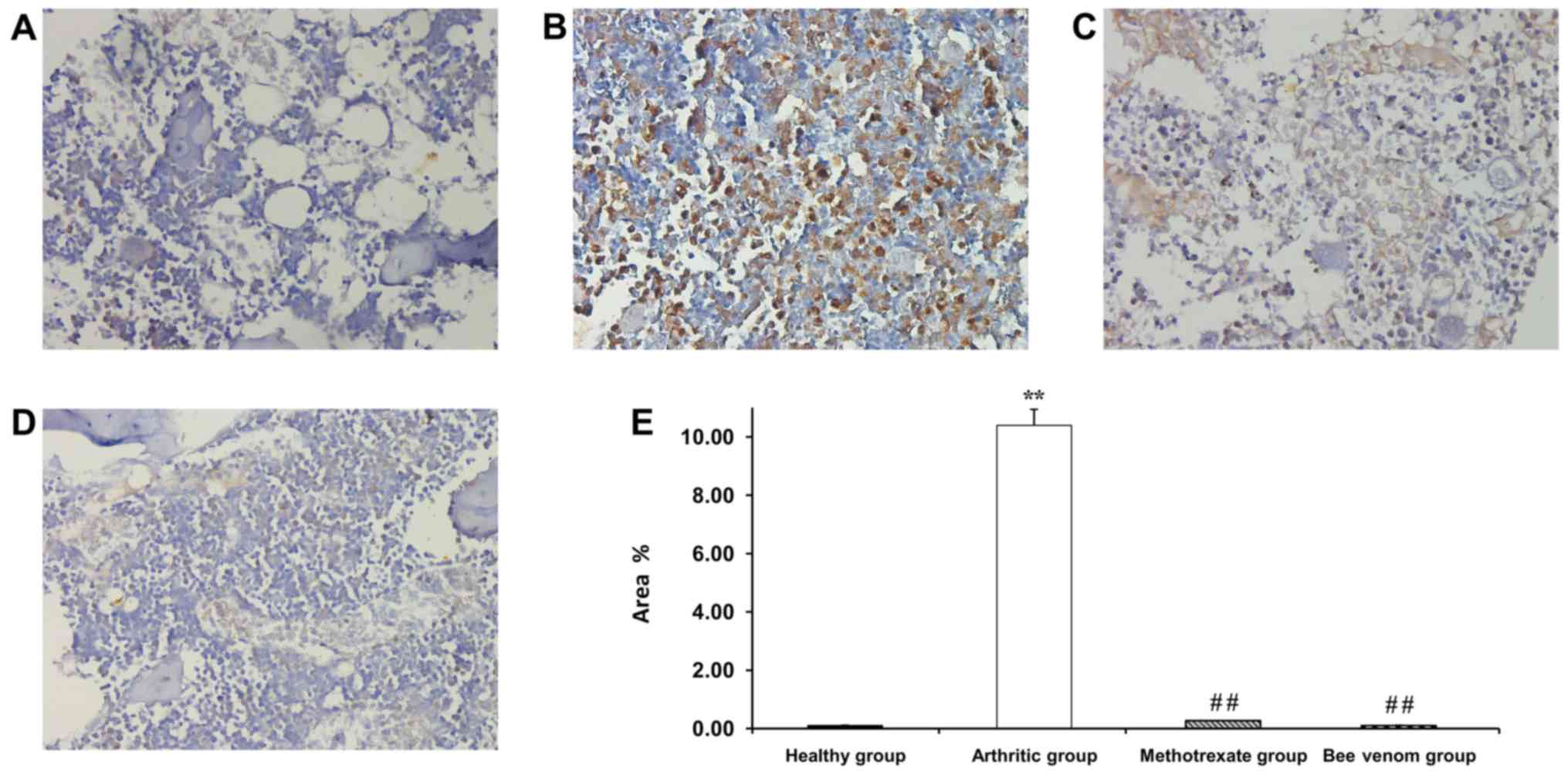|
1
|
Arnett FC, Edworthy SM, Bloch DA, Bloch
DA, McShane DJ, Fries JF, Cooper NS, Healey LA, Kaplan SR, Liang
MH, Luthra HS, et al: The American rheumatism association 1987
revised criteria for the classification of rheumatoid arthritis.
Arthritis Rheum. 31:315–324. 1988.PubMed/NCBI View Article : Google Scholar
|
|
2
|
Uhlig T, Moe RH and Kvien TK: The burden
of disease in rheumatoid arthritis. Pharmacoeconomics. 32:841–851.
2014.PubMed/NCBI View Article : Google Scholar
|
|
3
|
Bingham CO III: The pathogenesis of
rheumatoid arthritis: Pivotal cytokines involved in bone
degradation and inflammation. J Rheumatol Suppl. 65:3–9.
2002.PubMed/NCBI
|
|
4
|
Choy EH and Panayi GS: Cytokine pathways
and joint inflammation in rheumatoid arthritis. N Engl J Med.
344:907–916. 2001.PubMed/NCBI View Article : Google Scholar
|
|
5
|
Mateen S, Zafar A, Moin S, Khan AQ and
Zubair S: Understanding the role of cytokines in the pathogenesis
of rheumatoid arthritis. Clin Chim Acta. 455:161–171.
2016.PubMed/NCBI View Article : Google Scholar
|
|
6
|
Matsuno H, Yudoh K, Katayama R, Nakazawa
F, Uzuki M, Sawai T, Yonezawa T, Saeki Y, Panayi GS, Pitzalis C and
Kimura T: The role of TNF-alpha in the pathogenesis of inflammation
and joint destruction in rheumatoid arthritis (RA): A study using a
human RA/SCID mouse chimera. Rheumatology (Oxford). 41:329–337.
2002.PubMed/NCBI View Article : Google Scholar
|
|
7
|
Iwakura Y: Roles of IL-1 in the
development of rheumatoid arthritis: Consideration from mouse
models. Cytokine Growth Factor Rev. 13:341–355. 2002.PubMed/NCBI View Article : Google Scholar
|
|
8
|
Roman-Blas JA and Jimenez SA: NF-kappaB as
a potential therapeutic target in osteoarthritis and rheumatoid
arthritis. Osteoarthritis Cartilage. 14:839–848. 2006.PubMed/NCBI View Article : Google Scholar
|
|
9
|
Crofford LJ, Tan B, McCarthy CJ and Hla T:
Involvement of nuclear factor kappa B in the regulation of
cyclooxygenase-2 expression by interleukin-1 in rheumatoid
synoviocytes. Arthritis Rheum. 40:226–236. 1997.PubMed/NCBI View Article : Google Scholar
|
|
10
|
Poligone B and Baldwin AS: Positive and
negative regulation of NF-kappaB by COX-2: roles of different
prostaglandins. J Biol Chem. 276:38658–38664. 2001.PubMed/NCBI View Article : Google Scholar
|
|
11
|
Yamamoto Y and Gaynor RB: Role of the
NF-kappaB pathway in the pathogenesis of human disease states. Curr
Mol Med. 1:287–296. 2001.PubMed/NCBI View Article : Google Scholar
|
|
12
|
Rader K, Wildfeuer A, Wintersberger F,
Bossinger P and Mucke HW: Characterization of bee venom and its
main components by high-performance liquid chromatography. J
Chromatogr. 408:341–348. 1987.PubMed/NCBI View Article : Google Scholar
|
|
13
|
Kwon YB, Lee JD, Lee HJ, Han HJ, Mar WC,
Kang SK, Beitz AJ and Lee JH: Bee venom injection into an
acupuncture point reduces arthritis associated edema and
nociceptive responses. Pain. 90:271–280. 2001.PubMed/NCBI View Article : Google Scholar
|
|
14
|
Kim KW, Shin YS, Kim KS, Chang YC, Park
KK, Park JB, Choe JY, Lee KG, Kang MS, Park YG and Kim CH:
Suppressive effects of bee venom on the immune responses in
collagen-induced arthritis in rats. Phytomedicine. 15:1099–1107.
2008.PubMed/NCBI View Article : Google Scholar
|
|
15
|
Hwang DS, Kim SK and Bae H: Therapeutic
effects of bee venom on immunological and neurological diseases.
Toxins (Basel). 7:2413–2421. 2015.PubMed/NCBI View Article : Google Scholar
|
|
16
|
Khamis AA, Ali EM, El-Moneim MA,
Abd-Alhaseeb MM, El-Magd MA and Salim EI: Hesperidin, piperine and
bee venom synergistically potentiate the anticancer effect of
tamoxifen against breast cancer cells. Biomed Pharmacother.
105:1335–1343. 2018.PubMed/NCBI View Article : Google Scholar
|
|
17
|
Lee JD, Kim SY, Kim TW, Lee SH, Yang HI,
Lee DI and Lee YH: Anti-inflammatory effect of bee venom on type II
collagen-induced arthritis. Am J Chin Med. 32:361–367.
2004.PubMed/NCBI View Article : Google Scholar
|
|
18
|
Zatroch KK, Knight CG, Reimer JN and Pang
DS: Refinement of intraperitoneal injection of sodium pentobarbital
for euthanasia in laboratory rats (Rattus norvegicus). BMC
Vet Res. 13(60)2017.PubMed/NCBI View Article : Google Scholar
|
|
19
|
Liu YL, Lin HM, Zou R, Wu JC, Han R,
Raymond LN, Reid PF and Qin ZH: Suppression of complete Freund's
adjuvant-induced adjuvant arthritis by cobratoxin. Acta Pharmacol
Sin. 30:219–227. 2009.PubMed/NCBI View Article : Google Scholar
|
|
20
|
Lewis A and Levy A: Anti-inflammatory
activities of Cassia alata leaf extract in complete Freund's
adjuvant arthritis in rats. West Indian Med J. 60:615–621.
2011.PubMed/NCBI
|
|
21
|
Banji D, Pinnapureddy J, Banji OJ, Kumar
AR and Reddy KN: Evaluation of the concomitant use of methotrexate
and curcumin on Freund's complete adjuvant-induced arthritis and
hematological indices in rats. Indian J Pharmacol. 43:546–550.
2011.PubMed/NCBI View Article : Google Scholar
|
|
22
|
Chung JI, Barua S, Choi BH, Min BH, Han HC
and Baik EJ: Anti-inflammatory effect of low intensity ultrasound
(LIUS) on complete Freund's adjuvant-induced arthritis synovium.
Osteoarthritis Cartilage. 20:314–322. 2012.PubMed/NCBI View Article : Google Scholar
|
|
23
|
Larsson P, Kleinau S, Holmdahl R and
Klareskog L: Homologous type II collagen-induced arthritis in rats.
Characterization of the disease and demonstration of clinically
distinct forms of arthritis in two strains of rats after
immunization with the same collagen preparation. Arthritis Rheum.
33:693–701. 1990.PubMed/NCBI View Article : Google Scholar
|
|
24
|
Mossiat C, Laroche D, Prati C, Pozzo T,
Demougeot C and Marie C: Association between arthritis score at the
onset of the disease and long-term locomotor outcome in
adjuvant-induced arthritis in rats. Arthritis Res Ther.
17(184)2015.PubMed/NCBI View Article : Google Scholar
|
|
25
|
Jou JM, Lewis SM, Briggs C, Lee SH, De La
Salle B and McFadden S: International Council for Standardization
in Haematology. ICSH review of the measurement of the erythocyte
sedimentation rate. Int J Lab Hematol. 33:125–132. 2011.PubMed/NCBI View Article : Google Scholar
|
|
26
|
Kyei S, Koffuor GA and Boampong JN:
Antiarthritic effect of aqueous and ethanolic leaf extracts of
Pistia stratiotes in adjuvant-induced arthritis in
Sprague-Dawley rats. J Exp Pharmacol. 4:41–51. 2012.PubMed/NCBI View Article : Google Scholar
|
|
27
|
Petrovic-Rackov L and Pejnovic N: Clinical
significance of IL-18, IL-15, IL-12 and TNF-alpha measurement in
rheumatoid arthritis. Clin Rheumatol. 25:448–452. 2006.PubMed/NCBI View Article : Google Scholar
|
|
28
|
Klopfleisch R: Multiparametric and
semiquantitative scoring systems for the evaluation of mouse model
histopathology-a systematic review. BMC Vet Res.
9(123)2013.PubMed/NCBI View Article : Google Scholar
|
|
29
|
Darwish SF, El-Bakly WM, Arafa HM and
El-Demerdash E: Targeting TNF-α and NF-κB activation by bee venom:
Role in suppressing adjuvant induced arthritis and methotrexate
hepatotoxicity in rats. PLoS One. 8(e79284)2013.PubMed/NCBI View Article : Google Scholar
|
|
30
|
Blobaum AL and Marnett LJ: Structural and
functional basis of cyclooxygenase inhibition. J Med Chem.
50:1425–1441. 2007.PubMed/NCBI View Article : Google Scholar
|
|
31
|
Maclouf J, Grassi J and Pradelles P:
Development of enzyme-immunoassay techniques for measurement of
eicosanoids In: Prostaglandin and Lipid Metabolism in Radiation
Injury. Springer. pp355–364. 1987.
|
|
32
|
Vyas S, Agrawal RP, Solanki P and Trivedi
P: Analgesic and anti-inflammatory activities of Trigonella
foenum-graecum (seed) extract. Acta Pol Pharm. 65:473–476.
2008.PubMed/NCBI
|
|
33
|
Morris CJ: Carrageenan-induced paw edema
in the rat and mouse. Methods Mol Biol. 225:115–121.
2003.PubMed/NCBI View Article : Google Scholar
|
|
34
|
Domiati S, El-Mallah A, Ghoneim A, Bekhit
A and El Razik HA: Evaluation of anti-inflammatory, analgesic
activities, and side effects of some pyrazole derivatives.
Inflammopharmacology. 24:163–172. 2016.PubMed/NCBI View Article : Google Scholar
|
|
35
|
Taber RI, Greenhouse DD, Rendell JK and
Irwin S: Agonist and antagonist interactions of opioids on acetic
acid-induced abdominal stretching in mice. J Pharmacol Exp Ther.
169:29–38. 1969.PubMed/NCBI
|
|
36
|
Young HY, Luo YL, Cheng HY, Hsieh WC, Liao
JC and Peng WH: Analgesic and anti-inflammatory activities of
(6)-gingerol. J Ethnopharmacol. 96:207–210. 2005.PubMed/NCBI View Article : Google Scholar
|
|
37
|
Ghosh MN: Fundamentals of experimental
pharmacology. Indian J Pharmacol. 39(216)2007.
|
|
38
|
Yang RZ, Park S, Reagan WJ, Goldstein R,
Zhong S, Lawton M, Rajamohan F, Qian K, Liu L and Gong DW: Alanine
aminotransferase isoenzymes: Molecular cloning and quantitative
analysis of tissue expression in rats and serum elevation in liver
toxicity. Hepatology. 49:598–607. 2009.PubMed/NCBI View Article : Google Scholar
|
|
39
|
Husdan H and Rapoport A: Estimation of
creatinine by the Jaffe reaction A comparison of three methods.
Clin Chem. 14:222–238. 1968.PubMed/NCBI
|
|
40
|
Safiri S, Kolahi AA, Hoy D, Smith E,
Bettampadi D, Mansournia MA, Almasi-Hashiani A, Ashrafi-Asgarabad
A, Moradi-Lakeh M, Qorbani M, et al: Global, regional and national
burden of rheumatoid arthritis 1990-2017: A systematic analysis of
the global burden of disease study 2017. Ann Rheum Dis.
78:1463–1471. 2019.PubMed/NCBI View Article : Google Scholar
|
|
41
|
Luo H, Zuo XX, Li T and Zhang J: Effect of
bee venom on adjuvant induced arthritis in rats. Zhong Nan Da Xue
Xue Bao Yi Xue Ban. 31:948–951. 2006.PubMed/NCBI(In Chinese).
|
|
42
|
Kwon YB, Kang MS, Kim HW, Ham TW, Yim YK,
Jeong SH, Park DS, Choi DY, Han HJ, Beitz AJ and Lee JH:
Antinociceptive effects of bee venom acupuncture (apipuncture) in
rodent animal models: A comparative study of acupoint versus
non-acupoint stimulation. Acupunct Electrother Res. 26:59–68.
2001.PubMed/NCBI View Article : Google Scholar
|
|
43
|
Kocyigit A, Guler EM and Kaleli S:
Anti-inflammatory and antioxidative properties of honey bee venom
on freund's complete adjuvant-induced arthritis model in rats.
Toxicon. 161:4–11. 2019.PubMed/NCBI View Article : Google Scholar
|
|
44
|
Gohil P, Patel V, Deshpande S, Chorawala M
and Shah G: Anti-arthritic activity of cell wall content of
Lactobacillus plantarum in freund's adjuvant-induced
arthritic rats: Involvement of cellular inflammatory mediators and
other biomarkers. Inflammopharmacology. 26:171–181. 2018.PubMed/NCBI View Article : Google Scholar
|
|
45
|
Silva JC, Rocha MF, Lima AA, Brito GA, de
Menezes DB and Rao VS: Effects of pentoxifylline and nabumetone on
the serum levels of IL-1beta and TNFalpha in rats with adjuvant
arthritis. Inflamm Res. 49:14–19. 2000.PubMed/NCBI View Article : Google Scholar
|
|
46
|
Ahmed O, Fahim H, Mahmoud A and Eman Ahmed
EA: Bee venom and hesperidin effectively mitigate complete freund's
adjuvant-induced arthritis via immunomodulation and enhancement of
antioxidant defense system. Arch Rheumatol. 33:198–212.
2017.PubMed/NCBI View Article : Google Scholar
|
|
47
|
Kim HW, Kwon YB, Ham TW, Roh DH, Yoon SY,
Kang SY, Yang IS, Han HJ, Lee HJ, Beitz AJ and Lee JH: General
pharmacological profiles of bee venom and its water soluble
fractions in rodent models. J Vet Sci. 5:309–318. 2004.PubMed/NCBI
|
|
48
|
Vick JA and Shipman WH: Effects of whole
bee venom and its fractions (apamin and melittin) on plasma
cortisol levels in the dog. Toxicon. 10:377–380. 1972.PubMed/NCBI View Article : Google Scholar
|
|
49
|
Chang DM, Baptiste P and Schur PH: The
effect of antirheumatic drugs on interleukin 1 (IL-1) activity and
IL-1 and IL-1 inhibitor production by human monocytes. J Rheumatol.
17:1148–1157. 1990.PubMed/NCBI
|
|
50
|
Kane D, Gogarty M, O'Leary J, Silva I,
Bermingham N, Bresnihan B and Fitzgerald O: Reduction of synovial
sublining layer inflammation and proinflammatory cytokine
expression in psoriatic arthritis treated with methotrexate.
Arthritis Rheum. 50:3286–3295. 2004.PubMed/NCBI View Article : Google Scholar
|
|
51
|
Segal R, Mozes E, Yaron M and Tartakovsky
B: The effects of methotrexate on the production and activity of
interleukin-1. Arthritis Rheum. 32:370–377. 1989.PubMed/NCBI View Article : Google Scholar
|
|
52
|
Lucas S: The pharmacology of indomethacin.
Headache. 56:436–446. 2016.PubMed/NCBI View Article : Google Scholar
|
|
53
|
Todd PA and Sorkin EM: Diclofenac sodium A
reappraisal of its pharmacodynamic and pharmacokinetic properties,
and therapeutic efficacy. Drugs. 35:244–285. 1988.PubMed/NCBI View Article : Google Scholar
|
|
54
|
Nam KW, Je KH and Lee JH: Inhibition of
COX-2 activity and proinflammatory cytokines (TNF-alpha and
IL-1beta) production by water-soluble sub-fractionated parts from
bee (Apis mellifera) venom. Arch Pharm Res. 26:383–388.
2003.PubMed/NCBI View Article : Google Scholar
|
|
55
|
Park HJ, Lee SH, Son DJ, Oh KW, Kim KH,
Song HS, Kim GJ, Oh GT, Yoon DY and Hong JT: Antiarthritic effect
of bee venom: Inhibition of inflammation mediator generation by
suppression of NF-kappaB through interaction with the p50 subunit.
Arthritis Rheum. 50:3504–3515. 2004.PubMed/NCBI View Article : Google Scholar
|
|
56
|
Amin AR, Dave M, Attur M and Abramson SB:
COX-2, NO, and cartilage damage and repair. Curr Rheumatol Rep.
2:447–453. 2000.PubMed/NCBI View Article : Google Scholar
|
|
57
|
Ku EC, Lee W, Kothari HV and Scholer DW:
Effect of diclofenac sodium on the arachidonic acid cascade. Am J
Med. 80:18–23. 1986.PubMed/NCBI View Article : Google Scholar
|
|
58
|
Junger H and Sorkin LS: Nociceptive and
inflammatory effects of subcutaneous TNFalpha. Pain. 85:145–151.
2000.PubMed/NCBI View Article : Google Scholar
|
|
59
|
Leung L and Cahill CM: TNF-alpha and
neuropathic pain-a review. J Neuroinflammation.
7(27)2010.PubMed/NCBI View Article : Google Scholar
|
|
60
|
Dirig DM, Isakson PC and Yaksh TL: Effect
of COX-1 and COX-2 inhibition on induction and maintenance of
carrageenan-evoked thermal hyperalgesia in rats. J Pharmacol Exp
Ther. 285:1031–1038. 1998.PubMed/NCBI
|
|
61
|
Han SM, Lee GG and Park KK: Acute dermal
toxicity study of bee venom (Apis mellifera L.) in Rats.
Toxicol Res. 28:99–102. 2012.PubMed/NCBI View Article : Google Scholar
|
|
62
|
Han SM, Lee KG, Yeo JH and Pak SC: Dermal
and ocular irritation studies of honeybee (Apis mellifera
L.) venom. Am J Chin Med. 40:795–800. 2012.PubMed/NCBI View Article : Google Scholar
|
|
63
|
Grisotto LS, Mendes GE, Castro I, Baptista
MA, Alves VA, Yu L and Burdmann EA: Mechanisms of bee venom-induced
acute renal failure. Toxicon. 48:44–54. 2006.PubMed/NCBI View Article : Google Scholar
|


















